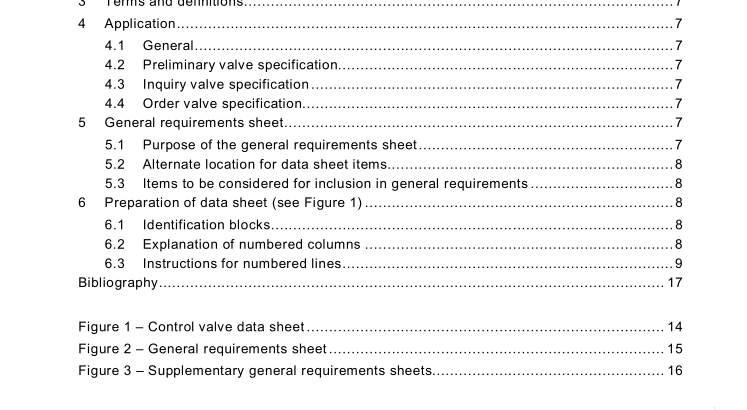IEC 60534-7:2010 pdf download – Vannes de régulation des processus industriels – Partie 7: Grille de définition de vanne de régulation
3Terms and definitions
For the purposes of this document, the terms and definitions given in the IEC 60534 seriesapply.
4Application
4.1General
The control valve data sheet(Figure 1) below may be used for three different levels of controlvalve selection.
4.2Preliminary valve specification
For a preliminary inquiry and/or quotation, buyer and vendor may agree on a minimum level ofinformation. In this case,the buyer and manufacturer mark a few lines only in column 1 by adot,triangle or other symbol.This method minimizes efforts for both buyer and vendor.
4.3lnquiry valve specification
ln inquiry stage, some of the process data and also some of the general requirements will notbe fully known and specified. This may not allow the application of the IEC calculationmethods given in IEC 60534-2-1 and lEC 60534-2-5.Preliminary valve sizing methods may beused at this stage. Since the main focus of the inquiry specification is to provide all datarequired to work out a comparable technical and commercial quote,in most cases there is aneed to mark additional lines beyond those in 6.1.Also on the inquiry specification,the linesin column 1 shall be marked by a dot, triangle or other symbol by the buyer and manufacturer.
4.4Order valve specification
A complete ordering specification should ideally include all relevant information about thevalve,actuator and accessories concerned. In this case,the fully completed control valvedata sheet becomes a kind of passport,which allows an exact identification and can be usedfor many purposes.
5 General requirements sheet
5.1 Purpose of the general requirements sheet
The purpose of the general requirements sheet (Figure 2), which is optional, is to provide ameans for the user to specify general or special requirements that are applicable to a valve orgroup of valves. Examples are national and international standards,user company standardsand special project requirements.These general or special requirements shall be listed in thetable of contents section of page 1 of the general requirements sheet. Supplementary generalrequirements sheets (Figure 3) may be used as necessary. It may also be necessary to cross-reference the general requirements sheet(s) with the data sheets. lf there is a conflictbetween the general requirements sheet and the data sheet, then the latter shall overrule.
NOTE For those countries that use 8,5 ´ 1 1 inch paper and where linefeed is limited to 1 /6 inch, the general requirements sheets can be shortened by deleting the appropriate length from the middle portion of the forms. The data sheet can be shortened by deleting the “Remarks” section. The use of computers permits an adjustable linefeed which allows the forms to be printed without the deletion of any lines.
5.2 Alternate location for data sheet items Any item on the data sheet (Figure 1 ) which cannot be adequately described in the available space shall be covered on the general requirements sheet.
5.3 Items to be considered for inclusion in general requirements Items not included on the data sheet may also be covered on the general requirements sheet. The following is a partial list of areas that may need to be considered and to be stated on the general requirements sheet:
a) terminology (see IEC 60534-1 );
b) codes, standards and regulations;
c) valve sizing (see IEC 60534-2-1 and 60534-2-5);
d) noise (see IEC 60534-8-3, respectively IEC 60534-8-4);
e) inspection and routine testing (see IEC 60534-4);
f) non-destructive examination;
g) marking (see IEC 60534-5);
h) documentation;
i) material requirements;
j) face-to-face dimensions (see IEC 60534-3-1 , IEC 60534-3-2 and IEC 60534-3-3)
k) final inspection requirements (see IEC 60534-4)
l) environmental considerations;
m) packaging;
n) accessories;
o) quality assurance requirements.
6 Preparation of data sheet (see Figure 1 )
6.1 Identification blocks
The identification blocks at the top and bottom of this form are designed to permit the user or contractor to add company name (upper left-hand corner), plant location, project number, tag number, piping and instrumentation (P and I) drawing number, and other specific project data.
